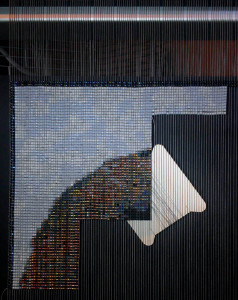I’ve now finished two small portraits of Squib, one for the WeaveWith project and one which was inspired by a poem I wrote myself. I’m planning on doing them both again — along with the larger “Feline Masterpiece” — after Christmas. I’ve got the makings of a “substitute for black” list of Delica colors, which I’m hoping will simplify the photo to design conversion process.
I don’t have time to write it all up right now, but I have a sequence of images that illustrates how the tapestry looks at different stages of the editing.
Here’s the original photo:
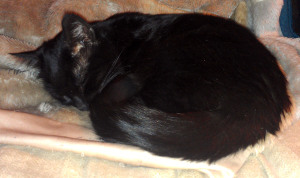 I used Photoshop to enhance the color of the picture. As black cat pictures go, this one has a lot of visible detail that will ease the pain of converting to a pattern. [There’s so much artistic and intellectual pain involved that every little bit of ease helps a lot, ugh.] The adjustment I made in Photoshop makes the photo’s colors look more like they would if you were looking at the subject outdoors, in sunlight. This improves the level of detail in the image.
I used Photoshop to enhance the color of the picture. As black cat pictures go, this one has a lot of visible detail that will ease the pain of converting to a pattern. [There’s so much artistic and intellectual pain involved that every little bit of ease helps a lot, ugh.] The adjustment I made in Photoshop makes the photo’s colors look more like they would if you were looking at the subject outdoors, in sunlight. This improves the level of detail in the image.
Next, I imported the picture into Bead Creator Pro (BCP). My custom palette includes transparent Delicas with no coatings except glazed; matte Delicas including most of the special finishes; and metallic Delicas that exist in nature. It’s about a third of the complete Delica range, and I much prefer how my photos convert when I’m using this set. [One entry in the “photo to pattern” posts will show how I came to this conclusion. Stay tuned.] Here’s what BCP did as it imported my image:
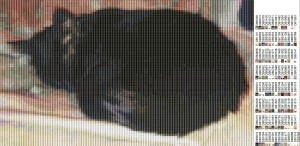 It used 95 colors, most of which are in the background of the picture (our bedspread). I used BCP’s “Use Only XX Colors” function to reduce the number of colors to 40:
It used 95 colors, most of which are in the background of the picture (our bedspread). I used BCP’s “Use Only XX Colors” function to reduce the number of colors to 40:
 There have been relatively small changes in Squib herself; most of the colors that were eliminated were in the background, which is exactly what I want.
There have been relatively small changes in Squib herself; most of the colors that were eliminated were in the background, which is exactly what I want.
This was as much processing as I could let BCP do. When I tried to go from 40 to 35 colors, I started losing significant details in Squib’s fur. So the rest of the processing is manual.
I gleefully threw out all the background and replaced it with stripes of green and lavender, mostly because I’d just gotten my hands on the gorgeous DB-1053, matte lavender/olive, yum. The only thing I did to Squib’s image was to clean things up around her left ear (she often had mucky ears, and has apparently carried that with her into her afterlife). The final-for-now pattern uses 28 colors.
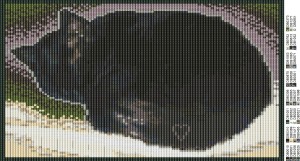 And here is the woven beaded tapestry, taken off my loom about an hour ago:
And here is the woven beaded tapestry, taken off my loom about an hour ago:
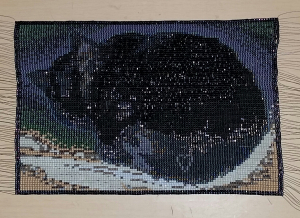 The large black areas are woven with DBC-0010 — the hex cut version of DB-0010, for non-Delica geeks. It’s got a bit more sparkle thanks to the cut, and I think it’s sufficiently different that I’ll be able to use it for highlights on areas filled with DB-0010.
The large black areas are woven with DBC-0010 — the hex cut version of DB-0010, for non-Delica geeks. It’s got a bit more sparkle thanks to the cut, and I think it’s sufficiently different that I’ll be able to use it for highlights on areas filled with DB-0010.
The grey shades look a lot lighter in beads than they did on the chart. I completely missed that Squib’s whiskers are visible in the raw version of the chart. They got smoothed out during the color reduction and I should have edited them back in manually. I’m going to revise the pattern by using darker beads than the original greys; using hex cut black Delicas as a highlight color (that gets rid of at least one metal, which will help naturalize things); and fiddling with the background some more.
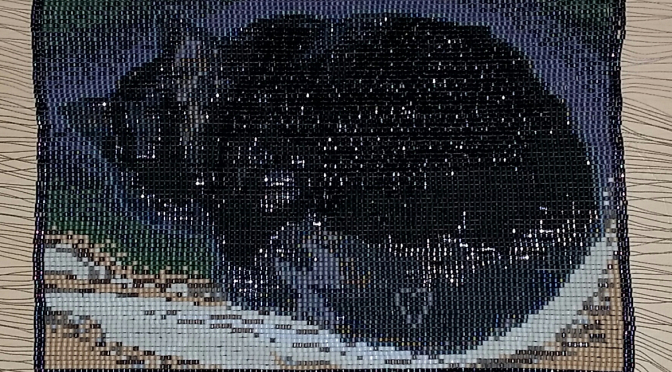

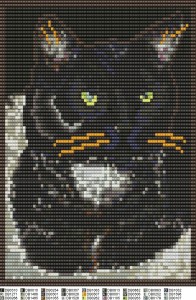

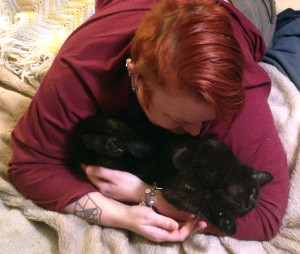
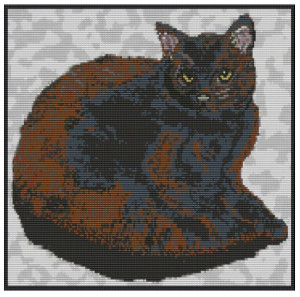 In addition to designing a pattern I liked, I had to figure out ways to handle such a large piece. The finished picture will be about 9″ by 9″, and is built out of 23,940 beads.
In addition to designing a pattern I liked, I had to figure out ways to handle such a large piece. The finished picture will be about 9″ by 9″, and is built out of 23,940 beads.